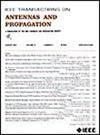Design of High-Efficiency Transmitarray With Beam-Steering and Low-Scattering Characteristic
IF 4.6
1区 计算机科学
Q1 ENGINEERING, ELECTRICAL & ELECTRONIC
引用次数: 0
Abstract
This article introduces a hybrid design method for high-efficiency absorbing reconfigurable transmitarray (ARTA). By cascading an absorbing layer with a 2-bit reconfigurable layer, the transmission unitcells can realize the frequency response characteristic of an absorbing-transmissive–absorbing (A-T-A). Specifically, the frequencies with an absorption rate exceeding 80% are within the ranges of 3.3–5.1 and 7.8–9.4 GHz, while the frequency range with transmission exceeding –3 dB spans from 5.69 to 5.92 GHz. Meanwhile, the transmission phase can be adjusted among four states: 0°, 90°, 180°, and 270°, enabling beam steering of ARTA. Compared to designs for nonreconfigurable transmissive arrays, our design methodology necessitates the satisfaction of absorbing performance under different phase states. For validation, a prototype sample, comprising a具有波束导向和低散射特性的高效发射阵列设计
介绍了一种高效吸收可重构发射阵列(ARTA)的混合设计方法。通过将吸收层与2位可重构层级联,传输单元可以实现吸收-传输-吸收(a -t - a)的频率响应特性。其中,吸收速率超过80%的频率范围为3.3 ~ 5.1 GHz和7.8 ~ 9.4 GHz,传输速率超过-3 dB的频率范围为5.69 ~ 5.92 GHz。同时,传输相位可以在0°、90°、180°和270°四种状态之间进行调节,实现了ARTA的光束导向。与不可重构发射阵列的设计相比,我们的设计方法需要满足不同相态下的吸收性能。为了验证,已经制作并测试了一个原型样品,该样品包括一个由五个金属层和四个介电层组成的$12 × 12$阵列,中间夹有一个空气层。测量结果表明,该天线在5.85 GHz时具有良好的辐射性能,峰值增益为21.6 dB,孔径效率为33.3%。BW-1和BW-3 dB分别为0.2和0.6 GHz。当波束指向0°时,e面和h面旁瓣电平(SLLs)分别为-17.3和-18 dB。在x偏振波的正常入射下,-8 dB单稳态RCS减少带宽为32.1% (3.4-4.7 GHz),为10% (8.5-9.4 GHz)。采用这种混合设计方法的ARTA为解决电磁兼容性问题和低可探测性应用提供了一个有吸引力的解决方案。
本文章由计算机程序翻译,如有差异,请以英文原文为准。
求助全文
约1分钟内获得全文
求助全文
来源期刊
CiteScore
10.40
自引率
28.10%
发文量
968
审稿时长
4.7 months
期刊介绍:
IEEE Transactions on Antennas and Propagation includes theoretical and experimental advances in antennas, including design and development, and in the propagation of electromagnetic waves, including scattering, diffraction, and interaction with continuous media; and applications pertaining to antennas and propagation, such as remote sensing, applied optics, and millimeter and submillimeter wave techniques

 求助内容:
求助内容: 应助结果提醒方式:
应助结果提醒方式:


